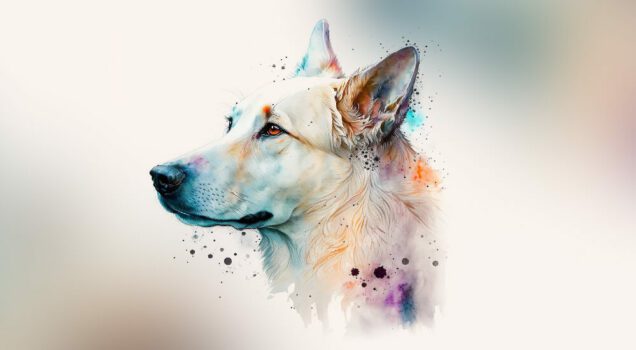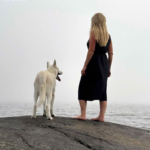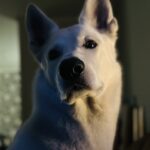
My thoughts about breeding – part 1
3 years ago by Linda
I have been looking for male dogs for a long time, all over the world, but unfortunately I have not been able to find one that suits my bitches which means that there will be no litter in 2022. The problem is not that there are no nice male dogs, the problem is that they are all closely related genetically to my dogs. How does that happen, one might wonder?
Genetics
Genetics is complicated, but if you want to simplify it as much as possible, you can compare it to a pool of water. Let’s say pool 1 contains 10,000 liters of water.
From these 10,000 liters, you take out 1,000 liters and pour into what we call pool 2. Then you mix these 1,000 liters of water with each other, over and over again. A few liters may be contaminated by handling, a few liters are spilled when mixing.
You then decide that a few liters of water should only be mixed with a few others, so you take 50 liters of water out of pool 2. You pour these into pool 3 and then you continue to mix them. A little water is spilled every time, a little water gets polluted every time. After a while, you may only have 30 liters left in pool 3, but you keep mixing the water anyway, year in and year out.
If you were to take a water sample from pool 1, 2 and 3, would you be able to distinguish the different pools from each other? Yes, you probably would as the last pool is probably more affected by handling than the first but you could see that it was basically the same water.
What am I trying to describe? Well, pool 1 is what we call the origin. The origin of the dog is the wolf, about 20,000-40,000 years ago (scientists still debate when the domestication took place, or perhaps rather the domestications as it seems that this happened on two occasions) the domestic dog was created. In the wolf there was such a great genetic variation that we have been able to create somewhere around 400 different breeds that look more or less different, and for a long time pool 1 contained all this variation in our domestic dogs.
Pool 2 is the breed formation. As an example, we can take the German Shepherd, it was taken from pool 1 and created from about 4 to 30 dogs. The genes of these dogs were thus poured into a separate pool, the one we call pool 2. These genes have been there since the end of the 19th century. It is still, more or less, the same “water” or genes. I say more or less because there are a handful of breeders who have had the sense to mix new genes into pool 2 over time.
Pool 3 is the formation of white shepherd dog. The white shepherd descends directly from the German shepherd, it was separated around the Second World War (because of its color) to be approved as its own breed 20 years ago. When a breed is approved, all supply of new water to the pool is shut off, i.e. the studbooks are closed. That means we mixed 50 liters of water for about 2 decades now. Closed stud books are thus a form of organized inbreeding which for the last 100-150 years has been sanctioned by our culture of inbreeding.
The difference in the creation and preservation of breeds
I think it is common for us to confuse the creation and preservation of breeds. Many of our breeds have been created through strict inbreeding. Some breeds have been created more or less by themselves by dogs within a large geographical area interbreeding over time and finally becoming a homogeneous group that is accepted as a breed. Those breed created by strict inbreeding, I would venture to say, generally have a high degree of genetic inbreeding today, while those who through more natural selection over time have come to form a breed have a relatively low degree of genetic inbreeding. However, today we have a number of breeds that are closed populations, that is, we do not mix these breeds with each other. We have created breeds from the genetically rich pool that I initially called Pool 1.
In order for a pool to be kept healthy and fresh, new water needs to be topped up at regular intervals. It must be kept clean and nice so that algae or other unwanted things do not take hold. With this I am trying to explain that new genetic material must be added to a breed continuously and that the breed you want to preserve must be kept clean and fine by health testing and evaluating the breeding animals before they go into breeding, so that we do not breed further unnecessary diseases or other misery which is hereditary. Adding new genetic material is preserving a breed.
New thoughts create anger
In the dog world these are radical thoughts for many and I already know long before I publish this that I will be keeled. But just because some (maybe quite a few) will get angry doesn’t mean they’re right. Why is this radical? Well, because we thought the same thoughts for 100-150 years. We have been breeding in this way, organized through all the world’s kennel clubs since the end of the 19th century. Anyone who thought differently, or didn’t feel comfortable going with the flow, was ostracized, bullied or banned from communities. This is not unique to the dog world, we humans probably just work that way. What is different or foreign is considered dangerous or unhealthy. Perhaps it is our built-in survival mechanism that kicks in when we react like that. I have, when this has come up, been urged by an angry breeder colleague to leave the FCI if I am so against what they stand for. (The FCI is an umbrella organization for most of our national kennel clubs.) I have been told to stop having White Swiss Shepherds if I am so against the breed. In a Facebook group of which I am a member, you must not mention the word German shepherd because the group is only for White Swiss Shepherds and all origins must be denied if you are a true follower of the breed. By publishing this I will perhaps lose some “friends” and probably one or two potential puppy buyers as well, but I can live with that. I understand that what I sometimes perceive as hatred or anger is actually rooted in fear and/or ignorance. Fear of the new. Inability to understand what the research says. Comments like “If you don’t think the same as us, you have nothing to do here”.
But we can be as scared, angry and incapable as we want – the research is clear – inbreeding leads to a reduced immune system, increased risk of cancer, allergies and other serious diseases that can adversely affect the dogs’ lives. Today, the worst possible scenario for many is that one breed would mix with another, not that the risk of recessively inherited diseases takes hold in a breed or that a weakened immune system can lead to a gastrointestinal tract that does not function optimally, or that the dog gets cancer and die far too young.
Many wants this to be about me and that I am against purebred dogs and think that I should engage in mixed breeding if I have these thoughts. But they haven’t understood that I am in favour of breeds. I love to sit and watch different breeds, to get to know different individuals within different breeds and that I want to preserve this. What is happening in society today is that it is becoming more and more popular with mixed breed and I can understand that to some extent. But it would be extremely sad if all our breeds just faded away, disappeared. There is a big difference between crossing in new genetic material to strengthen a breed and unplanned mixed breeding, at least in my opinion.
Light in the tunnel
Today, there are breeders around the world who are educated, knowledgeable and determined to preserve their favorite breed by adding new genetic material, a little at a time, with the best interests of the breed in mind. They exist in fairly closed forums because the current climate does not allow for new ways of thinking. A lot of knowledge is exchanged within these forums and you could compare it to someone opening a window to a room that has been closed for 100 years. The oxygen flows in and hope is lit. There are breed clubs around the world that have taken the bull by the horns and stood up for their breed and started crossbreeding projects. Our kennel clubs have gradually realized that it will not be possible to continue as we have done for so long. Understandably, almost no one dares to stand on the barricade in this matter, especially not the kennel clubs that depend on their members. In 20-30 years the matter will no longer be radical, we will not have closed studbooks, we will have healthier and stronger dogs than what we have today. All that is needed is that we who dabble in breeding come to the full use of our senses. I don’t know if I’ll be alive in 20-30 years, but one thing I know is that I dare to climb the barricade already today and deep down I know I’m not alone there. It probably just feels that way right now.
If I should stop breeding, maybe you are thinking now? No, I’m not going to stop breeding, but I’m not going to continue breeding the White Shepherd to ruin.
For those who are interested, I am attaching a small selection of links, but recommend that you search for the available research yourself:
- Framtidens hundar – möjligheter och utmaningar med ett hållbart avelsarbete.
- What are the Consequences of Inbreeding Dogs?
- Understanding the Coefficient of Inbreeding
- Linebreeding vs. Inbreeding – Let’s be perfectly clear.
- The challenges of pedigree dog health: approaches to combating inherited disease.
Related posts
Posts that are published in the same categories.


